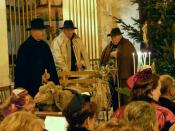Christmas came from the phrase "Christ's mass" and was derived from old English "Cristes Maesse" (Wikipedia, n.d.). It is a day when Christian's celebrate the birth of their savior, Jesus Christ. Celebration of Christmas includes gift-giving, Christmas trees, display of Nativity sets, church attendance, the Father Christmas/Santa claus myth, and family gatherings. Christmas is often denoted as "X-mas", the reason for this is that the letter X resembles a Greek letter abbreviated as Christ (Wikipedia, n.d.). Christmas is being celebrated creatively in the Philippines. The Philippines celebrate Christmas at a very long time. It starts on December 16, and ends at January 6. The Philippines is the only Asian country where Christians predominate; therefore, majority of the people celebrate Christmas (Fertig, 1990).
In Spain, Christmas starts at December 8 with the celebration of the feats of the Immaculate Conception ("Santas", n.d.). In the Philippines, Christmas is started with a mass called "Misa de Gallo".
"Misa de Gallo" is a Spanish term meaning "Mass of the Rooster" (Fertig, 1990). The reason why it is named the mass of the rooster is because the mass starts at a very early morning. The mass is celebrated nine mornings until Christmas Eve. And as the next mass will be celebrated, it is first preceded by a "Simbang Gabi" - a tagalong term for night mass (Fertig, 1990). Some say that masses are held at an early time as a form of sacrifice; others contend that it was for farmers who wanted to be working in their fields at the crack of dawn. Whatever the reason may be, "Simbang Gabi" is a must for today's Filipinos. "Simbang Gabi" is attended by everyone including children. Although some adults think that children need more rest, many other think it as an important venue for children.


